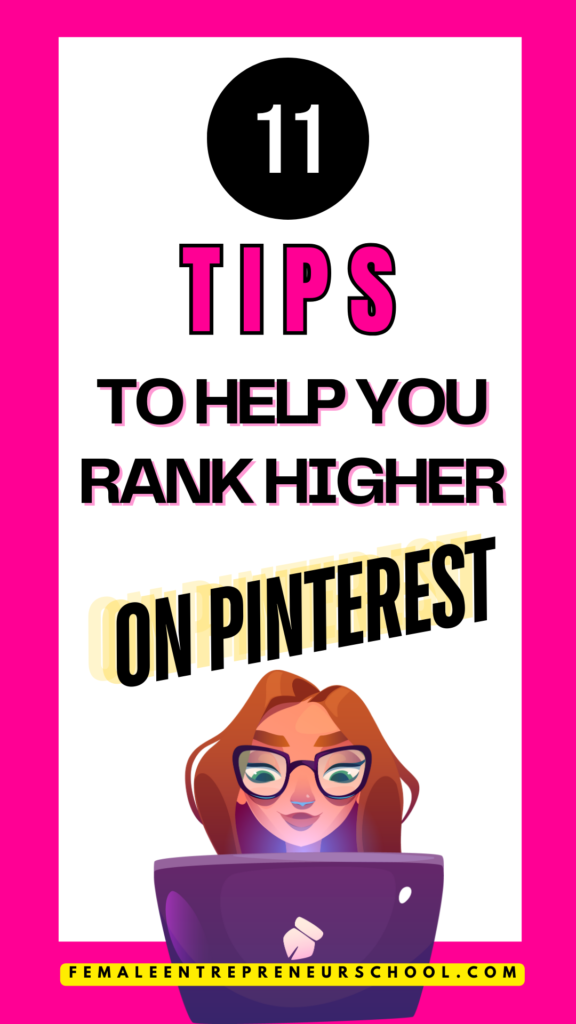11 Tips To Help You Rank Higher On Pinterest

Bonus Material: 50 Best Pinterest Tips – Free Guide
This blog post is for any female small business owner who wants to drive organic traffic to their business, and to do so without having to rely so heavily on social media.
The following ten tips will help your Pinterest pins rank higher on Pinterest, so that your pins are seen by people in Pinterest’s home feed, increasing your chances of pin clicks, pin saves and outbound clicks of organic traffic to your business.
Pinterest can be absolutely brilliant for organic traffic when you use the best and most current Pinterest strategy.
These tips will help. Let’s dive right in.

- Optimize Your Profile Make sure your Pinterest profile is fully optimized. Use a clear, high-quality profile picture, preferably your logo or a professional headshot. Have a great Pinterest banner that looks enticing, and clearly demonstrates who you are and what you do. Write a compelling bio that includes relevant keywords related to your niche. Don’t forget to include a link to your website or lead magnet, so that people can head into the deeper parts of your small business.
- Use Keywords Strategically Just like with any search engine, keywords are crucial on Pinterest. The entire platform works off keywords for SEO. Use relevant keywords in your profile, on your pin titles, pin descriptions, board titles and board descriptions. Think about what keywords your target audience is inside Pinterest searching for, and incorporate those keywords into your pins, your boards and your profile naturally. Don’t keyword dump. It may impact your account.
- Create Pinterest Friendly Content Your boards, your pins, and the destination url’s your pins lead to should all be Pinterest friendly. This means doing some research inside Pinterest to find out what your audience is there searching for, and then creating content around those search terms, to give your pins a greater chance of being found and connected with. Your starting point on Pinterest is to make sure your pins and the urls those pins lead to contain content that is as Pinterest friendly as possible.
- Create Relevant Pinterest Boards Your Pinterest board titles should be keyword optimised for Pinterest. Your board descriptions should also be keyword optimised for Pinterest. You should have enough boards that you can pin to regularly and consistently. A good rule of thumb when starting out is to have 2-3 Pinterest friendly boards.
- Create High-Quality, Vertical Pins Pinterest prefers vertical images with a 2:3 aspect ratio. Pins that are 1000 pixels x 1920 pixels are good. You should not go bigger than this. I find this size pin stands out and works best on the platform. Ensure your pins are visually appealing, high-quality, and have your logo or website URL. Use original images wherever possible. Canva is a great tool for creating eye-catching pins.
- Write Compelling Pin Descriptions Write engaging pin descriptions that include relevant keywords. Describe what the pin is about and what users can gain if they click on the pin to go to the url you have attached to it. Don’t keyword dump in your pin descriptions. You’re trying to encourage people to take action here, to go to the url attached.
- Consistent Pinning Schedule Consistency is key on Pinterest. Aim to pin regularly every day. Make sure every pin you send live is a fresh pin (not a direct copy of any pin you have already sent live). I and the ladies in my community manage to get decent growth pinning 2-3 fresh pins each day, five days a week. However, the more fresh pins you can introduce daily, the better. It’s important to manage this in a way where you can stay consistent and not burn out.
- Engage with Your Audience Engage with your followers by responding to comments and messages. It’s not often spoken about, but Pinterest does like and take into account number of followers on your account. Followers demonstrates to Pinterest the popularity of your content. If people leave comments this again will be taken into account by Pinterest. Be sure to respond to any comments people leave.
- Join and Group Boards Joining group boards can expand your reach to a larger audience. Make sure the group boards you join are relevant to your niche, are current and have high engagement. You should be joining group boards that have a higher level of monthly impressions and engagement than your own account.
- Monitor Analytics and Adjust Strategy Regularly check your Pinterest Analytics to see which pins and boards are performing best. When you see your best performing pins over time, make more Pinterest friendly content based on those topics, and pin fresh pins for that content regularly and consistently. Always leave a space of 5-10 days between pinning fresh pins to the same url. Use your insights to refine your strategy, focusing on what’s working best, and eliminating any topics that aren’t gaining traction over the longer haul. Remember your pins don’t just immediately take off – it could be months or years before a pin gains traction on the platform – but it’s best to focus on creating more content based around your best performing pins.
- Stay Current with Pinterest Trends Keep an eye on Pinterest’s trending topics and seasonal trends. Creating content around trending topics can boost your visibility. Pinterest Predicts is a great resource for understanding upcoming trends on the platform. However you may find that Pinterest predicts doesn’t really cover the topics you pin for (this happens to me). That’s ok. It’s always worth checking to see if anything related to your niche is trending. Remember to post for seasonal events (like Christmas) if you have topic-related content and pins at least 6 months before the event happens.
BONUS MATERIAL: 50 Best Pinterest Tips Guide
RELEVANT POSTS
HOW TO FIND PINTEREST FRIENDLY TOPICS FOR YOUR BLOG POSTS
